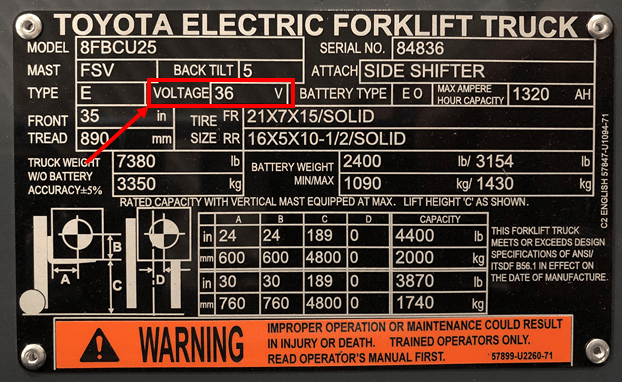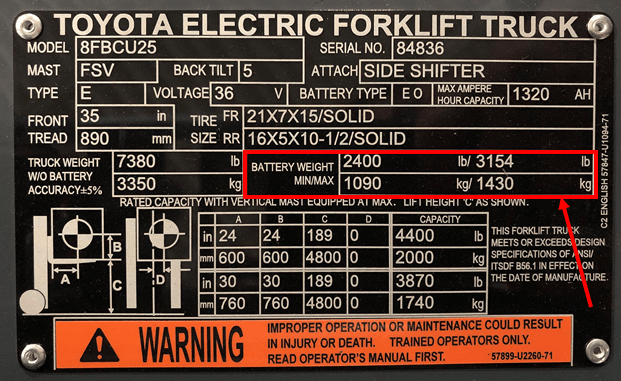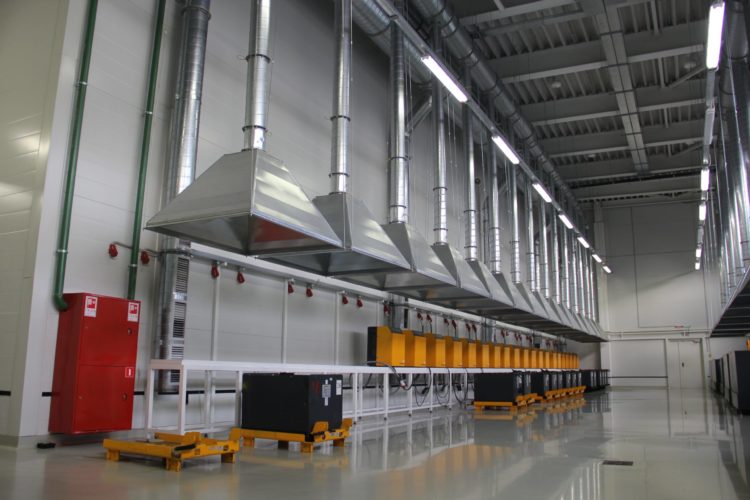
This is the ultimate forklift battery guide.
This guide contains an in-depth analysis of forklift batteries.
In it, you’ll learn:
- The different types, voltages, sizes, and weights of forklift batteries
- The average prices of different forklift batteries
- How to properly charge a forklift battery
- Maintenance tips for keeping your forklift batteries healthy
Let’s dive in!
Generally, electric forklifts are powered by one of two types of forklift batteries:
- Lead-acid
- Lithium-ion
We’ll cover each below.
Lead-Acid Batteries
Also called “wet cell batteries,” lead-acid forklift batteries are the most common on the market.

Components of lead-acid batteries include:
- Battery case
- Cells
- Bars
- Plates of lead dioxide
- Cables
- A mixture of water and sulfuric acid
These batteries generate electricity through an electrochemical reaction between lead plates and a mixture of sulphuric acid and water.
Lead-acid forklift batteries generally last between 1,000 and 1,500 cycles.
That equals about 3 to 5 years with over 300 workdays per year.
Lithium-Ion Batteries
Lithium-ion forklift batteries are gaining popularity partly because they offer many benefits compared to lead-acid batteries, such as:
Sealed cells to eliminate leaks
Short charging period
No water maintenance
Environmental friendliness
The components of lithium-ion batteries are a cathode, electrolyte (lithium), separator, anode, and two current collectors (positive and negative).

Lithium-ion batteries have many different chemistries for energy production.
But the most popular one for forklifts is lithium iron phosphate.
In this process, while the battery is discharging electrolyte liquid, positively charged lithium-ions are carried from the anode to the cathode to generate power.
This process is reversed when the battery is being charged.
If maintained well, a lithium-ion forklift battery will last between 2,000 and 3,000 cycles.
That equals about 7 to 10 years of 300 workdays per year.
Forklift batteries come in different voltages.
Usually, the voltage depends on the size of your equipment.
But some equipment requires specific voltages to operate.
You should always confirm the voltage that your forklift can handle.
That’s because a wrong voltage can cause significant damage to the equipment.
If you’re not sure, it’s best to consult the lift truck data plate or owner’s manual.

Typically, the common voltages for forklift batteries include:
12 Volts: Designed for small and light lift equipment such as powered pallet jacks
24 Volts: Ideal for smaller electric lift equipment such as center riders, end riders, walkie stackers, and electric walkie pallet jacks
36 Volts: Designed and ideal for mid-size electric lift trucks such as narrow aisle forklifts and 3-wheelers
48 Volts: Designed for larger lift machines such as 4-wheel counterbalanced forklifts
80 Volts: Used for large material handling such as pneumatic counterbalanced forklifts
There are hundreds of different forklift battery sizes, depending on your lift truck’s size, brand, make, and model.
In general, the larger the forklift you operate, the larger the battery size.
Often, you can find the size displayed on the battery’s nameplate.

If that is missing, however, you can check the cell connectors nearest to the positive terminal.
There, you can find the model number, serial number, and weight stamped.

The model number is ultimately what will tell you the size of the battery.
For example, take the model 18-85-17, where:
- The first number indicates the number of cells. It also doubles as an indication of the voltage, since each cell is 2 volts. Therefore, an 18-cell battery is 36 volts
- The second number represents the plate design capacity
- The third number shows the number of plates in each cell. Uniquely, this number is always odd
You can quickly tell the size of the battery by looking at the plates per cell.
Thus, an 18-85-17 is a smaller battery than an 18-85-29.
You might be wondering: How much does a forklift battery weigh?
Overall, forklift batteries can weigh anywhere from 600 lbs. to 5,000 lbs. or more for the biggest electric lift trucks.
The weight of forklift batteries is important because they serve two purposes:
- To power the lift truck
- To act as a counterbalance for the forklift’s stability during operation
Consequently, the bigger the forklift, the more the battery will weigh.
So installing a heavier or lighter battery than what the manufacturer recommends could create a safety hazard because of counterbalance issues.
You can avoid this by checking the forklift data plate, which lists the weight range requirement.

Forklift batteries can vary widely in price, depending on the model and manufacturer.
But in general, a lead-acid forklift battery costs between $2,000 and $9,000 or more.
Here are the average prices for the most common lead-acid forklift battery models:
6-85-11 = $1,200
12-85-13 = $2,500
12-125-13 = $3,300
18-85-17 = $4,800
18-85-33 = $9,200
18-125-13 = $4,300
24-85-17 = $6,200
24-85-27 = $10,500
40-125-11 = $7,600
** These prices are only rough averages
Lithium-ion batteries can be more than twice as expensive as lead-acid batteries, but they also offer higher rewards.
Forklift batteries can be dangerous to work with.
Some of the hazards include:
Crushing: Heavy forklift battery weight exposes operators to crushing hazards, which can lead to significant physical injuries
Shocks: Stored electricity in forklift battery cells can short circuit and shock an operator upon touch
Chemical burns: Acid-filled batteries can leak and cause serious chemical burns if the sulfuric acid comes to contact with the skin
Explosions: During the battery charging process, forklift batteries emit flammable hydrogen gas. This gas can cause flames or explosions if allowed to build to excessive levels
Temperature burns: High operating temperatures can expose operators to burn hazards
Corrosion: Sulfuric acid is corrosive and can cause floor and equipment corrosion if it splashes out of the battery
OSHA recommends the following safety practices to keep safe when working with batteries:
- Wear the right personal protective equipment (hard hats, gloves, apron, face shield or goggles, safety footwear, and other PPE)
- Ensure you keep battery covers open for proper heat dispersal during charging
- Keep the charging area well ventilated
- Keep clear of the forklift battery while it’s being moved or lifted
- Remove all metal jewelry before entering the charging area. This includes anything metallic, from tools to earrings
- Do not lay metallic items on the top of an uncovered battery to prevent sparking and electric shock
- Check water and electrolyte levels before beginning charging, but never add water. Only add water after charging is complete
- Never add electrolyte - only add water. Contact a forklift battery professional if acid needs to be added
- Take active precautions with flammable materials
- When attaching charging clamps, start by connecting the positive clamp to the positive terminal. Then connect the negative clamp to the negative terminal
- Keep the charger unplugged and turned off while attaching or detaching the battery’s clamp connections
- If the battery heats up or if fluid starts leaking from the vents, turn off the charger and restart the process at a lower rate of charge
- Ensure you record water levels in a designated battery service log
- If you have to wash batteries, use the right cleaning solution and washing equipment. Only wash batteries in a contained space
- Don’t rinse battery water down the drain. Battery wash water is hazardous
When it comes to charging a forklift battery, here are the important things you must consider:
- The type of forklift battery
- The charging method
- The optimal charging time of the battery
- The battery charging station requirements
Depending on the type of battery you have and how many shifts it works, you can use two different forklift battery charging methods: Conventional charging or opportunity charging.
We’ll cover each below.
Conventional Charging
Conventional charging is the normal way of charging a battery.
It is popular with lead-acid batteries and works best if you’re running a one-shift operation.

With this method, you charge the battery at the end of a shift and resume use when the battery is fully charged.
The downside of this method is that it decreases the amount of time the forklift operates, and subsequently its productivity.
But the upside is that conventional charging is the least damaging way to charge a lead-acid battery.
Opportunity Charging
Opportunity chargers use a higher power output to quickly charge a battery on an as-needed basis.
The need basis can be whenever there’s an opportune moment to charge the battery, such as when the forklift operator is on a lunch break.

Overall, opportunity charging works best for multi-shift operations.
That’s because you can quickly get charged without having to swap batteries.
Lithium-ion forklift batteries are best suited for opportunity charging because they don't need to be recharged to 100% battery capacity.
On the other hand, while you can opportunity charge lead-acid batteries, it’s less desirable.
The reason is that the higher power outputs from an opportunity charger can damage the battery and shorten its lifespan.
Forklift Battery Charging Area Requirements
Lead-acid batteries have specific battery charging area requirements that lithium-ion batteries do not.
This is because lead-acid batteries have the potential for safety hazards such as acid leaks and spills, venting explosive gases, and high temperatures.

Consequently, OSHA requires a blend of preventive measures and emergency equipment in all forklift battery charging areas.
OSHA states that:
“Charging a forklift battery produces highly flammable hydrogen gas. Clear instructions should be present for how to respond to any emergency such as acid spill or fire accurately.”
So, according to OSHA, the designated battery charging area must have the following safety requirements:
Fire extinguisher
Phone for communication in case of emergencies
Eyewash station (that supports at least 15 minutes of flow)
Readily available neutralization materials (such as soda ash or baking soda) to neutralize spilled acid
Ready access to water
Adequate ventilation to disperse flammable hydrogen gas
No smoking signs. Smoking in the charging area is prohibited to prevent accumulated hydrogen from exploding
Appropriate personal protective equipment. This should include goggles, hard hats, face shields, rubber aprons, rubber/neoprene gloves, and safety toe footwear
Adequate warning labels identifying hazards
Forklift Battery Charging Procedure
Forklift battery charging is done close to electricity and sulphuric acid.
So it should only be done by trained employees.
Once the battery is ready for charging, make sure you’re wearing protective gear before starting.
Then, follow the steps below to charge the battery:
-
Safely park the truck in the charging station and apply the brakes
-
Ensure the charger voltage matches the battery voltage
-
Ensure that the charger is turned off before connecting the battery
-
Ensure the charger cables are in good working condition
-
Open the hood on the truck. This allows for easier venting of any gasses that are released
-
Disconnect the battery connector from the truck
-
Plug the battery connector into the charger’s connector
-
Once connected, allow ample charging time. Lead-acid forklift batteries require a full eight-hour charge to distribute the acid throughout the battery properly
-
Keep battery covers and hoods open for proper heat dispersal during charging
-
To prevent boilovers, add distilled or deionized water after charging, preferably using a water gun. Do this only after the battery has cooled down
How Long Does it Take to Charge a Forklift Battery?
A lead-acid forklift battery requires 8-10 hours to charge fully if it was down to 30% capacity.
After charging, the battery should be allowed 8 hours to cool down.
The charge and use cycle for a lithium-ion battery is a 1-hour charge, 8 hours of use, and another 1-hour charge.
Additionally, lithium-ion batteries do not require a cooling period.
Proper forklift battery maintenance plays a critical role in preserving the useful life span of your forklift battery.

Maintenance requirements depend on the type of battery you’re using and your work operations.
Lithium-ion batteries are sealed and require little to no maintenance.
On the other hand, lead-acid batteries require frequent maintenance to prevent degradation of the chemical process and preserve their operating capacity and lifespan.
The key activities in forklift battery maintenance include:
- Proper charging
- Watering
- Equalizing
- Washing
Let’s go through these items.
Charging
Proper forklift battery maintenance requires that you only charge at certain times and only to certain degrees.
Be sure to charge your lead-acid battery when it’s no less than 20% discharged.

And remember never to interrupt a charge cycle on lead-acid batteries and not to undercharge or overcharge it.
Instead, let the battery charge until the charger says it’s 100% complete.
For lithium-ion batteries, you can do opportunity charging.
Watering
Forklift battery watering is essential for maintaining optimum capacity and preventing premature failure.
Since lithium-ion batteries do not require watering, this section will be exclusively about lead-acid batteries.
In a lead-acid battery, water protects the battery’s active material.

And if the water level drops too low, the active material dries out.
This in turn can permanently damage the forklift battery and shorten its useful life.
You might be wondering: How often should you water a forklift battery?
The answer is that you should water the battery every five to ten charging cycles.
That said, since every battery can be different, it’s best to check the manufacturer’s recommendations to be sure.
When it comes to the procedure for watering your batteries, there are a few things to keep in mind:
Use only distilled or deionized water to fill your batteries. Minerals in tap water can damage the battery and impair its performance
Never overfill a forklift battery with water. This can cause an overflow, which can spill sulfuric acid and lead to injury and a loss of battery capacity. Instead, only fill until the water level is just about the cell plate. This will leave enough space for the liquids inside the battery to expand when the battery is in use
Always top up water after a full charge or equalize charge (never before) and preferably after it has cooled down. This is when the battery’s water level is at its highest level, and you can see the level before topping it off
Equalizing
Equalization charging or “equalizing” for short is essentially a forced battery overcharge, which causes bubbling and gassing inside the cells.
Equalizing serves two purposes:
- Removing lead sulfate crystals from the battery plates before they harden
- Rebalancing the electrolyte concentration by reversing stratification
Stratification is when the water and acid separate.
When this happens, the acid becomes more concentrated at the bottom of the battery, reducing the battery’s capacity.
By causing bubbling and gassing in the cells, equalization reverses stratification by remixing the battery’s water-acid mixture.
You may be wondering: How often should you equalize your batteries?
The answer is that equalizing frequency depends on your battery manufacturer and level of battery use.
It can range from once a month to once or twice a year.
When it comes to how to equalize a battery, keep in mind that you’ll need to use a battery charger that has an equalizing setting.
Not all forklift battery chargers offer this functionality.

Once you have the appropriate charger, equalizing is pretty straightforward:
-
Remove all battery loads
-
Connect the charger to the battery
-
Set the charger to the battery’s manufacturer-guided equalization charge level
-
Switch on the charger, ensuring the electrolyte begins gassing and bubbling
-
Measure and monitor the specific gravity of the cells. This will increase with charging
-
Equalizing is complete when the specific gravity of the cells no longer increases
-
Once done, replace any water lost during the equalizing once the battery has cooled
Washing
By washing forklift batteries and keeping them clean, you will promote work safety through:
- Reducing workplace hazards from sulphuric acid
- Extending the battery’s useful life by reducing exterior battery and lift truck corrosion from leaked acid
- Improving the battery’s charge time by reducing electrolyte build-up on charging terminals
So how often should you wash your forklift batteries?
At least once per year, unless your batteries get dirty enough to warrant more frequent washing.
Conclusion
There you have it: The ultimate forklift battery guide.
Now, we’d like to hear from you.
Are you a forklift operator?
If so, what did you learn about forklift battery handling that we’ve discussed here?
Let us know in the comments section below!









